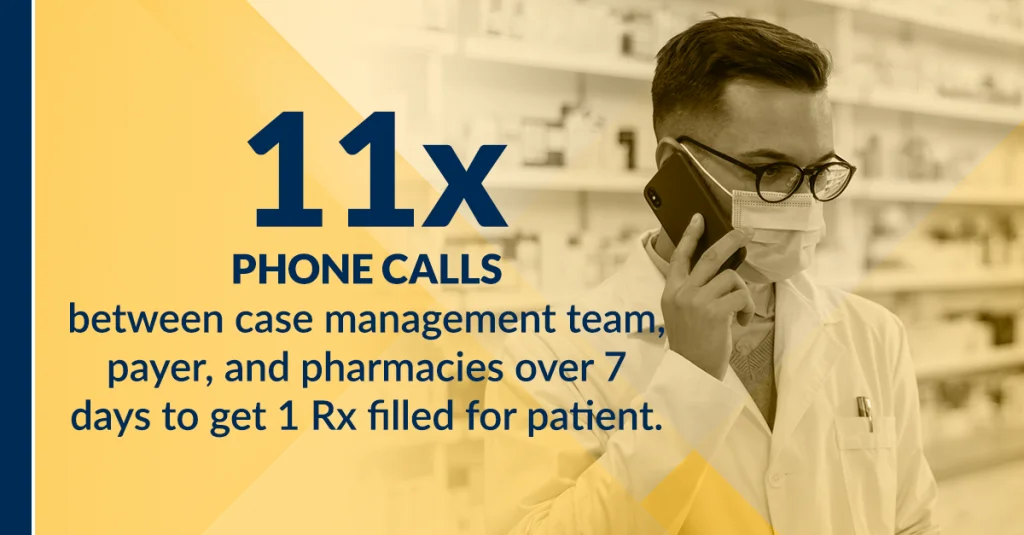A conversation with Brian Torres, Partner, Herspiegel and Danny Sigurdson, CEO, Courier Health
Pharmaceutical manufacturers have been striving to better support patients by placing them at the center of strategic planning. This has created a shift toward more holistic support services that look at the broader ecosystem of social and emotional support. Many of these support programs are designed to meet patients where they are, and in a channel they are comfortable with. In order to increase patient starts and reduce attrition, the evolving digital ecosystem needs to be integrated to remove the barriers that prevent patients from starting or staying on therapy. One of the companies enabling this new operating model to engage and support patients throughout a broader healthcare journey is Courier Health. I recently sat down with Danny Sigurdson, Cofounder and CEO, to discuss the infrastructure required for these patient-centric models.

Brian Torres:
How is Courier Health enabling pharma companies to better support patients? How is this different from past approaches?
Danny Sigurdson:
Courier Health provides a technology platform that enables Pharmaceutical companies to achieve their patient experience goals. Pharma companies spend billions of dollars per year on clinical research and educating healthcare providers about their medicines. However, when HCPs actually start prescribing these medicines, 3 out of every 10 patients never start treatment and another 3 drop treatment in the first two months. Often the vast majority of these never starts or discontinuations are due to process complexity and could be avoided.
Our platform gives pharmaceutical companies a single source of truth to understand their patients, proactively surface issues, and orchestrate seamless journeys to help patients start and stay on therapy.
Ultimately every company wants their patients to have a high-touch personalized experience, but to scale support programs you need a next-generation technology that combines intelligence and automation. Our mission is to reinvent the patient experience by eliminating administrative burden and unnecessary barriers. The solution has improved the patient experience tremendously, while also delivering double-digit improvements to patient starts, time-to-start, and ongoing adherence.
Brian Torres:
Which types of products or companies would benefit most from your platform?
Danny Sigurdson:
Our current focus is on marketed products, so we work with commercial teams on FDA-approved therapies or late clinical-stage preparing for launch. Every product will benefit from a better understanding of the patient population and coordinating a thoughtful experience, however, specialty therapies for chronic conditions or rare diseases are an obvious fit.
These innovative products tend to have more complicated access processes with prior authorization, benefits investigation and verification, financial assistance, and coordinating with a specialty pharmacy. They might also have important onboarding steps such as titration, injection training, or a pre-treatment protocols for cell and gene therapies.
These are all important and valuable services, but they add some complexity to the patient journey, which is why rare disease companies are often at the forefront of innovation in Patients Support services. In order to scale a coordinated, high-touch experience to larger patient populations it is even more critical to leverage technology and automation.
Brian Torres:
Pharmaceutical companies have been accelerating digital investments. What have you observed as the impact on patient experience and outcomes?
Danny Sigurdson:
This has been exciting because patient information is Courier Health’s focus, so having data inputs from more sources gives us more information. We integrate with any client partner or system, internal or external, and we compliantly integrate data that is covered under patient consent. An exciting example is continuous glucose monitoring (CGM) where there is still a lot to learn from integrating the data and devices, but it’s allowed physicians and patients to manage diseases like diabetes in much better and more effective ways.
During the pandemic, care delivery was forced to evolve with telehealth. While this trend has receded, there has been a healthy rethinking about how to remove friction from the process to access care and execute the care plan. Pharma manufacturer’s definition of a seamless patient experience must pick up from the provider’s definition otherwise it’s not seamless to the patient. Related, I think we’re starting to see fulfillment and distribution being forced to innovate. Retail pharmacies, the traditional specialty pharmacy players, and now the more modern amazon-like delivery options like Phil, Capsule, Alto, etc. It’s a more convenient option for the huge chunk of population that now prefers getting products shipped directly to their home when they don’t need to participate in the “shopping” experience. This fulfillment process also creates richer data for understanding and proactively supporting the patient journey. Was the script filled? Was financial assistance applied accurately? Was it shipped or received by the patient? Again, fulfillment is just one example of digital investments, but it unlocks the ability to better support patients to ensure they can start and stay on therapy.
Brian Torres:
What are some examples of patient support programs transforming the experience and outcomes, and what are the critical elements of those programs?
Danny Sigurdson:
A few examples come to mind: rise of Field Reimbursement Managers (FRMs), expansion of pre-launch engagement, improving the intake process, and coordination of omnichannel communications.
Field reimbursement managers play a critical role as they are quarterbacking the patient experience from the field. They don’t always get the technology or tools they need to coordinate across the prescribers and pharmacy networks. Some companies, like Acadia Pharmaceuticals, are doing an incredible job elevating this role and equipping their team with tools and processes to ensure patient success.
Another example I mentioned is making investments to engage and understand your patient population pre-launch. Disease education campaigns help engage your future patient population and doing this pre-launch helps ensure you understand the different cohorts and their needs. That allows for more informed commercial planning and Patient Support program design. It also enables Pharma to launch products to an existing and engaged audience. It’s another area where Rare disease and specialty companies are setting the standard.
Brian Torres:
I agree, these are great examples. What do you think the common thread is? What are the critical factors to ensure these investments positively impact patients and increase the therapy start and stays?
Danny Sigurdson:
It is critical to have a single system of record that can coordinate the entire patient experience. It is essential for roles like FRMs and the remote monitoring programs we mentioned. However, the real value is being proactive with the information. Courier Health will scan all of the inputs and outputs and touchpoints and flag where the friction is. That enables pharmaceutical manufacturers to proactively surface these events and remove barriers to ensure that the patient can move forward. Identifying the right intervention to smooth out the experience for the patient is critical to increasing new therapy starts and reducing the attrition rate, which again are devastatingly low across the industry today. It’s a disservice to patients and unacceptable – we’re excited to provide a technology solution that finally addresses this major gap.
Brian Torres:
Danny, it has been great talking with you. Patient Support teams provide essential emotional, financial, and educational support, but it takes more than financial support or a starter kit. If pharma companies want to improve the patient experience and keep more patients on therapy, they need to build the infrastructure to support these programs. Step one in our Patient Services Design Model is to understand patient needs, then analyze gaps, and recommend ways our clients can better support their patients. A next-gen platform like Courier Health enables an opportunity to design and implement support programs where patients start and stay on therapy.
You can read more about this in Courier Health’s latest whitepaper, The State of Patient-Centricity in Biopharma. You can find more patient services resources in our insights hub.
Are your patient support programs enrolling and retaining patients?
Herspiegel leverages decades of commercial pharmaceutical expertise and innovations in the marketplace to partner with our clients on patient services strategy and implementation. Let’s talk.


